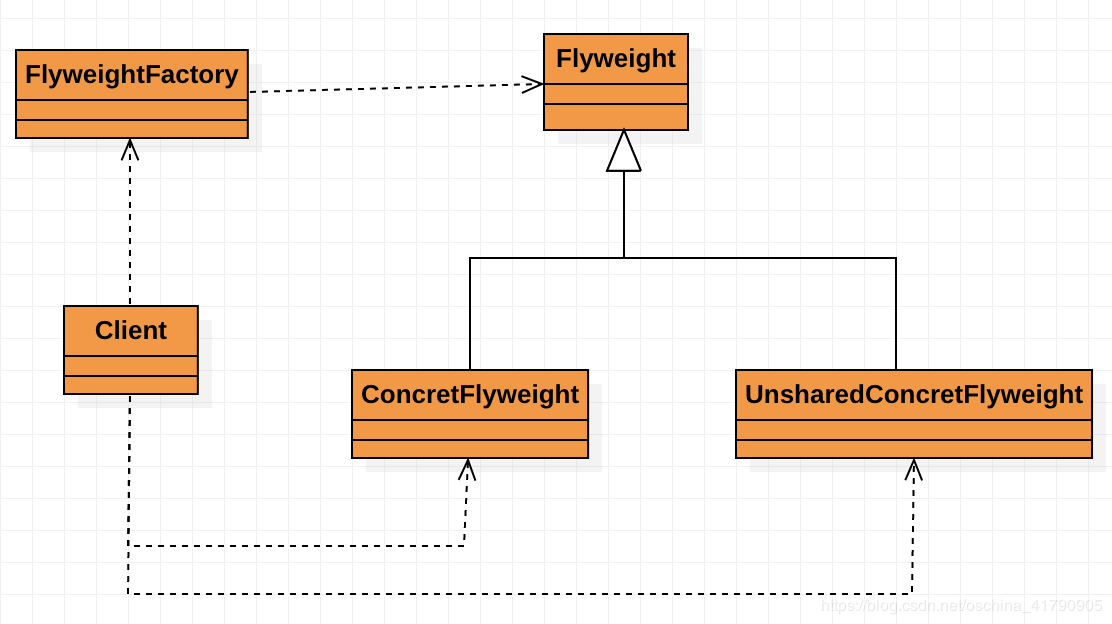享元模式(Flyweight),使用共享技术有效地支持大量细粒度的对象。常用于系统底层开发,解决系统的性能问题。比如,数据库连接池技术。
享元模式能够解决重复对象的内存浪费的问题,当系统中有大量相似对象,需要缓冲池时,不需总是创建新对象,可以从缓冲池里获取。这样可以降低系统内存消耗,同时提高效率。
享元模式经典的应用场景就是池技术了,String 常量池、数据库连接池、缓冲池等等都是享元模式的应用,它是池技术的重要实现方式。
要应用享元模式,我们需要将对象属性分为内部属性和外部属性。内部属性使对象唯一,而外部属性由客户端代码设置并用于执行不同的操作。
享元模式解析
角色介绍
- Flyweight:它是所有具体享元类的超类或接口,通过这个接口,Flyweight 可以接受并作用于外部状态。
- ConcreteFlyweight:它是继承 Flyweight 超类或实现 Flyweight 接口,并为内部状态增加存储空间。
- UnsharedConcreteFlyweight:它是指那些不需要共享的Flyweight子类。因为 Flyweight 接口共享成为可能,但它并不强制共享。
- FlyweightFactory:它是一个享元工厂,用来创建并管理 Flyweight 对象.它主要是用来确保合理地共享 Flyweight ,当用户请求一个 Flyweight 时,Flywei ghtFactory 对象提供一个 已创建的实例或者创建一个(如果不存在的话)。
享元模式基本代码
- Flyweight 类
public interface Flyweight {
void operation(int status);
}
- ConcreteFlyweight 类
public class ConcreteFlyweight implements Flyweight {
@Override
public void operation(int status) {
System.out.println("具体的 Flyweight: " + status);
}
}
- UnshareConcreteFlyweight 类
public class UnshareConcreteFlyweight implements Flyweight {
@Override
public void operation(int status) {
System.out.println("不共享的具体Flyweight: " + status);
}
}
- FlyweightFactory 类
public class FlyweightFactory {
private static Map<String, Flyweight> flyweightMap = new HashMap<>();
private FlyweightFactory() {
}
public static Flyweight getFlyweight(String key) {
Flyweight flyweight = flyweightMap.get(key);
if (flyweight == null) {
if (Objects.equals(key, "A")) {
flyweight = new ConcreteFlyweight();
}
if (Objects.equals(key, "B")) {
flyweight = new ConcreteFlyweight();
}
flyweightMap.put(key, flyweight);
}
return flyweight;
}
}
- Client 类
public class Client {
public static void main(String[] args) {
// 外部状态
int status = 2;
Flyweight flyweightA = FlyweightFactory.getFlyweight("A");
flyweightA.operation(status);
Flyweight flyweightB = FlyweightFactory.getFlyweight("B");
flyweightB.operation(status + 1);
// 不共享的 Flyweight
UnshareConcreteFlyweight unshareConcreteFlyweight = new UnshareConcreteFlyweight();
unshareConcreteFlyweight.operation(status + 2);
}
}
示例
假设我们需要使用线条和椭圆形创建图形。因此,我们将有一个接口 Shape 和它的具体实现为 Line 和 Oval。椭圆类将具有固有属性,以确定是否用给定的颜色填充椭圆,而 Line 将不具有任何固有属性。
使用享元模式实现
- Shape 类
public interface Shape {
public void draw(int x, int y, int width, int height, Color color);
}
- Line 类
public class Line implements Shape {
public Line(){
System.out.println("Creating Line object");
}
@Override
public void draw(int x1, int y1, int x2, int y2,
Color color) {
System.out.println("Draw Line");
}
}
- Oval 类
public class Oval implements Shape {
// 内部属性
private boolean fill;
public Oval(boolean isFill){
this.fill = fisFill;
System.out.println("Creating Oval object");
}
@Override
public void draw(int x, int y, int width, int height,
Color color) {
System.out.println("Draw Oval");
if(fill){
System.out.println("Fill Oval with color");
}
}
}
- ShapeFactory 类
public class ShapeFactory {
private static final Map<ShapeType,Shape> shapes = new HashMap<ShapeType,Shape>();
public static Shape getShape(ShapeType type) {
Shape shape = shapes.get(type);
if (shape == null) {
if (type.equals(ShapeType.OVAL_FILL)) {
shape = new Oval(true);
} else if (type.equals(ShapeType.OVAL_NOFILL)) {
shape = new Oval(false);
} else if (type.equals(ShapeType.LINE)) {
shape = new Line();
}
shapes.put(type, shape);
}
return shape;
}
public static enum ShapeType{
OVAL_FILL, OVAL_NOFILL, LINE;
}
}
- Client 类
public class Client {
public static void main(String[] args) {
Shape shape = ShapeFactory.getShape(ShapeType.LINE);
// 伪代码
shape.draw(x1, y1, x2, y2);
Shape shape1 = ShapeFactory.getShape(ShapeType.LINE);
// 伪代码
shape1.draw(x1, y1, x2, y2);
}
}
当我们多次创建 Line 图形时,由于程序使用了共享库,因此程序将快速执行。
小结
当我们需要创建一个类的许多对象且没有足够的内存容量时,可以使用享元模式。由于每个对象都会占用至关重要的内存空间,因此可以应用享元模式来通过共享对象来减少内存负载,同时也能提高程序效率。
事实上,享元模式可以避免大量非常相似类的开销。在程序设计中,有时需要生成大量细粒度的类实例来表示数据。如果能发现这些实例除了几个参数外基本上都是相同的,有时就能够受大幅度地减少需要实例化的类的数量。如果能把那些参数移到类实例的外面,在方法调用时将它们传递进来,就可以通过共享大幅度地减少单个实例的数目。
